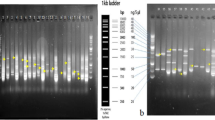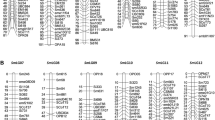Abstract
Oats are the fifth largest planted area in the world, and are the only cereal crops in the world to be among the top ten in the world. However, since oats are weak in cold weather, only four varieties are cultivated in Korea at present. Therefore, we constructed the DNA profile database using the EST-SSR marker for the oat 73 varieties kept in Korea. When the oat 73 cultivars marketed in Korea were tested with the eight EST-SSR marker developed in this study, 71.62 average alleles were detected per marker and the mean of PIC value was 0.337. According to the polymorphism of microsatellite markers, 73 varieties of oats were classified into 5 ~ 9 groups and most of the genetic resources investigated were identified when EST-SSR marker was used. In the future, EST-SSR markers developed in this study may be used to identify the seed disputes and breeds of oats. In addition, it predicts that it will be usefully used as a means of evaluating the characteristics of oat genetic resources, testing purity and studying the cultivation of varieties.
Similar content being viewed by others
References
Ai CX, Lu L, Ma GB, Liu ZX. 2005. Application of SSR markers in hybrid seed purity test of melon. Acta Horticulturae Sinica. 32(5): 902–904
Becher R. 2007. EST-derived microsatellites as a rich source of molecular markers for oats. Plant Breeding. 126(3): 274–278
Cave NA, Wood PJ, Burrows VD. 1990. Improvement in the nutritive value of naked oats for broiler chicks by various feed additives. Can. J. Anim. Sci. 70: 623
Chung H, Jeong YM., Chung WH, Mun JH, Kim N, Yu HJ. 2014. Genome-wide Marker Development for Radish (Raphanus sativus) Using Next GenerationSequencing. J. Hortic. Sci. Technol. 102–102
Daou C, Zhang H. 2012. Oat beta-glucan: its role in health promotion and prevention of diseases. Comprehensive Reviews in Food Science and Food Safety. 11(4): 355–365
Da-Silva PR, Milach Da-Silva PR, Milach SCK, Tisian LM. 2011. Transferability and utility of white oat (Avena sativa) microsatellite markers for genetic studies in black oat (Avena strigosa). Genet. Mol. Res. 10: 2916–2923
Deleu W, Esteras C, Roig C, González-To M, Fernández-Silva I, Gonzalez-Ibeas D, Blanca J, Aranda M, Arus P, Neuz F, Monforte AJ. 2009. A set of EST-SNPs for map saturation and cultivar identification in melon. BMC Plant Biology. 9(1): 90
Feng SP, Li WG, Huang HS, Wang JY, Wu YT. 2009. Development, characterization and cross-species/genera trans-ferability of EST-SSR markers for rubber tree (Hevea brasiliensis). Molecular Breeding. 23(1): 85–97
Fu YB, Chong J, Fetch T, Wang ML. 2007. Microsatellite variation in Avena sterilis oat germplasm. Theoretical and Applied Genetics. 114(6): 1029–1038
Gupta PK, Rustgi S, Sharma S, Singh R, Kumar N, Balyan HS. 2003. Transferable EST-SSR markers for the study of polymorphism and genetic diversity in bread wheat. Molecular genetics and genomics. 270(4): 315–323
Hu G, Jackson EW, Bonman JM. 2007. Expansion of PCR-based marker resources in oat by surveying genome-derived SSR markers from barley and wheat. Crop science. 47(5): 2004–2012
Hu JB, Zhou XY, Li JW. 2010. Development of novel EST-SSR markers for cucumber (Cucumis sativus) and their transferability to related species. Scientia horticulturae. 125(3): 534–538
Jaccard P. 1908. Nouvelles recherches sur la distribution florale. Bull. Soc. Vaud. Sci. Nat. 44: 223–270
Jia XP, Shi YS, Song YC, Wang GY, Wang TY, Li Y. 2007. Development of EST-SSR in foxtail millet (Setaria italica). Genetic Resources and Crop Evolution. 54(2): 233–236
Kim HI, Hong CP, Im S, Choi SR, Lim YP. 2014. Development of molecular markers and application for breeding in Chinese cabbage. Korean J. Hortic. Sci. Technol. 32(6): 745–752
Kumar S, Tamura K, Jakobsen IB, Nei M. 2001. MEGA2: molecular evolutionary genetics analysis software. Bioinformatics. 17(12): 1244–1245
Kwon YS, Park EK, Park CU, Bae KM, Yi SI, Cho IH. 2006. Identification of rice variety using Simple Sequence Repeat (SSR) marker. Journal of Life Science. 16(6): 1001–1005
Newman RK, Newman CW, Fadel J, Graham H. 1987. Nutritional implications of beta-glucans in barley. Barley Genetics. 773: 780
Penner GA, Chong J, Levesque-Lemay M, Molnar SJ, Fedak G. 1993. Identification of a RAPD marker linked to the oat stem rust gene Pg3. Theoretical and Applied Genetics. 85(6–7): 702–705
RAJHATHY T, THOMAS H. 1972. Genetic control of chromosome pairing in hexaploid oats. Nature New Biology. 239(94): 217
Rohlf FJ. 1993. Numeric taxonomy and multivariate analysis system. NTSYS-pc
Santana QC, Coetzee MP, Steenkamp ET, Mlonyeni OX, Hammond GN, Wingfield MJ, Wingfield B D. 2009. Microsatellite discovery by deep sequencing of enriched genomic libraries. Biotechniques. 46(3): 217–223
Sarwar MH, Sarwar MF, Sarwar M, Qadri NA, Moghal S. 2013. The importance of cereals (Poaceae: Gramineae) nutrition in human health: A review. Journal of cereals and oilseeds. 4(3): 32–35
Smith JSC, Chin ECL, Shu H, Smith OS, Wall SJ, Senior ML, Ziegle J. 1997. An evaluation of the utility of SSR loci as molecular markers in maize (Zea mays L.): comparisons with data from RFLPs and pedigree. Theoretical and Applied Genetics. 95(1–2): 163–173
Sorrells ME, Simmons SR. 1992. Influence of environment on the development and adaptation of oat. Oat science and technology. (oatscienceandte). 115–163
Varshney RK, Chabane K, Hendre PS, Aggarwal RK, Graner A. 2007. Comparative assessment of EST-SSR, EST-SNP and AFLP markers for evaluation of genetic diversity and conservation of genetic resources using wild, cultivated and elite barleys. Plant Science. 173(6): 638–649
Wang Y, Guo X. 2007. Development and characterization of EST-SSR markers in the eastern oyster Crassostrea virginica. Marine Biotechnology. 9(4): 500–511
Wang Z, Li J, Luo Z, Huang L, Chen X, Fang B, Li Y, Chen J, Zhang X. 2011. Characterization and development of EST-derived SSR markers in cultivated sweetpotato (Ipomoea batatas). BMC plant biology. 11(1): 139
Würsch P, Pi-Sunyer FX. 1997. The role of viscous soluble fiber in the metabolic control of diabetes: a review with special emphasis on cereals rich in β-glucan. Diabetes care. 20(11): 1774–1780
Zalapa JE, Cuevas H, Zhu H, Steffan S, Senalik D, Zeldin E, McCOWN B, Harbut R, Simon P. 2012. Using next-generation sequencing approaches to isolate simple sequence repeat (SSR) loci in the plant sciences. American journal of botany. 99(2): 193–208
Zhai W, Tian Q, Jia J, Dong Y. 2002. Identification of purity of Hami melon hybrid with AFLP fingerprint. Acta Horticulturae Sinica. 29(6): 587–587
Acknowledgements
This work was supported by a grant from the Next-Generation BioGreen 21 Program (Project No. PJ01364 7032019), Rural Development Administration, Republic of Korea.
Funding
This research did not receive any specific grant from funding agencies in the public, commercial, or not-for-profit sectors.
Author information
Authors and Affiliations
Corresponding author
Additional information
Conflicts of interest
The authors declare that there are no conflicts of interest regarding the publication of the paper.
Rights and permissions
About this article
Cite this article
Isabel, L.P., Park, JR., Lee, G.S. et al. Development of EST-SSR Markers and Analysis of Genetic Relationship it’s Resources in Hexaploid Oats. J. Crop Sci. Biotechnol. 22, 243–251 (2019). https://doi.org/10.1007/s12892-019-0158-0
Received:
Revised:
Accepted:
Published:
Issue Date:
DOI: https://doi.org/10.1007/s12892-019-0158-0




